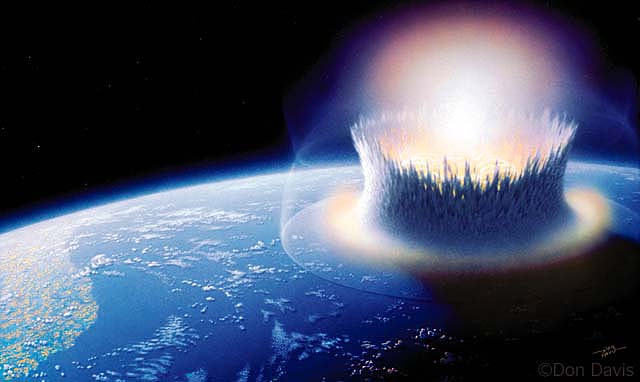
Meteorite
Impacts in Space and Time
|
|
|
|
|
Tsunami!!!
The phenomenon we call a tsunami (soo-NAH-mee) is a series of waves of extremely long wavelength and period generated in a body of water by an impulsive disturbance that displaces the water. Tsunami is the Japanese word for "harbor wave."
http://observe.ivv.nasa.gov/nasa/exhibits/tsunami/tsun_whatis.html

Tsunamis are caused by rapid perturbations of the seabed or of the water column above it, which either lift the sea surface up above its normal level (the usual case) or depress it. The perturbation may also accelerate a mass of water laterally; the resistance to the motion of this moving mass provided by the surrounding stationary water will also cause the water surface to rise. Gravity then acts to restore equilibrium in this source area, but inertia causes the moving water to overshoot the stable level in an oscillation that produces a series of waves, or wave train, which then propagates outwards from the source area until it either dissipates or collides with a coastline.
http://www.nerc-bas.ac.uk/tsunami-risks/html/Causes1.htm
A tsunami travels radially outward from its "epicenter" in concentric circles, like pond ripples. Waves will also travel long distances without losing any of its original power. Even if islands or reefs stand in the tsunami’s path, its force is not significantly reduced. Usually the waves don’t dissipate until they strike a continental land mass, and some waves even "bounce," traveling back and forth across the Pacific Ocean for over a week.

http://www1.tpgi.com.au/users/tps-seti/spacegd7.html
The great pulse of water usually passes unnoticed beneath ships at sea. The height from crest to trough is usually only a few feet, and the distance between two crests more than 100 miles. The wave’s speed equals the square root of the product of acceleration and the water depth. In other words, the waves travel faster in deeper water.
http://library.thinkquest.org/C003603/english/tsunamis/whatsatsunami.shtml
When it approaches shore, the wave rises. It is the sharp elevation of the ocean floor near the coast that slows the bottom of the wave while the top keeps moving at the original speed. Vast quantities of water are then piled up into a vertical wall, 100 feet or higher, that finally crashes over the shore with amazing force. (see previous link)
The first sign of an approaching tsunami is the sea tide draining away from the shore. The sea bottom is exposed for a large distance out. Then, the ocean water flows back in, higher and faster than before. These changes may be repeated several times before the tsunami itself roars in to land.

At the coast, the tsunami flood level (run-up) associated with a tsunami is partly due to the propagated waves but it is also greatly influenced by the topography of the coastal zone.
http://www.nerc-bas.ac.uk/tsunami-risks/html/Causes1.htm
Luckily, we have never seen a tsunami as a result of an impact with our own eyes. However, we do have some evidence that they have occurred in the history of the earth. On example of this is on the island of Lanai, Hawaii. Here scientists found sea material such as pebbles, round boulders, and coral as high as 350 m above sea level.
(Seymour, R.J. Evidence of oceanic impact of large meteorites. Appears In LPI Contribution., no. 449. p. 51. Houston, TX: Lunar and Planetary Institute, 1981.)
Because of the small wave height a tsunami has during much of its journey through deep water, a reliable early detection system for tsunamis has yet to be developed. The Pacific Tsunami Warning Center (PTWC) in Hawaii is the regional operational center for tsunami information in the Pacific. Two types of bulletins are released to advise of a possible approaching tsunami, a Tsunami Watch Bulletin and a Tsunami Warning Bulletin.
http://observe.ivv.nasa.gov/nasa/exhibits/tsunami/tsun_whatis.html
DATABASE LINKS
(From EJC and OhioLINK)
Asteroid Impact Tsunami: A Probabilistic Hazard Assessment
Steven N. Ward and Erik Asphaug
Institute of Tectonics, Earth and Marine Sciences Building, University of California, Santa Cruz, California 95064
E-mail: ward@uplift.ucsc.edu
Received April 5, 1999; revised November 30, 1999
(From EJC)
Bedforms produced by impact-generated tsunami,,2.6 Ga Hamersley basin,
Western Australia
S.W. Hassler a, * , H.F. Robey b , B.M. Simonson
c
a Department of Geological Sciences, California State University, Hayward, Hayward, CA 94542, USA
b Lawrence Livermore National Laboratory, Livermore, CA 94550, USA
c Department of Geology, Oberlin College, Oberlin, OH 44074, USA
Received 30 December 1998; accepted 2 July 1999
Sedimentary Geology 135 (2000) 283–294 http://www.elsevier.nl/locate/sedgeo
(From EJC and OhioLINK)
Damage from comet-asteroid impacts with earth
Jack G. Hills _, M. Patrick Goda
Theoretical Astrophysics Group, T-6, MS B288, Theoretical Division, Los Alamos National Laboratory, Los Alamos, NM 87545, USA
Physica D 133 (1999) 189–198.